Roman Coins and The Monetary System of the Roman Empire
The Roman monetary system, how was it working and what were the types of Roman coins and their evolution.
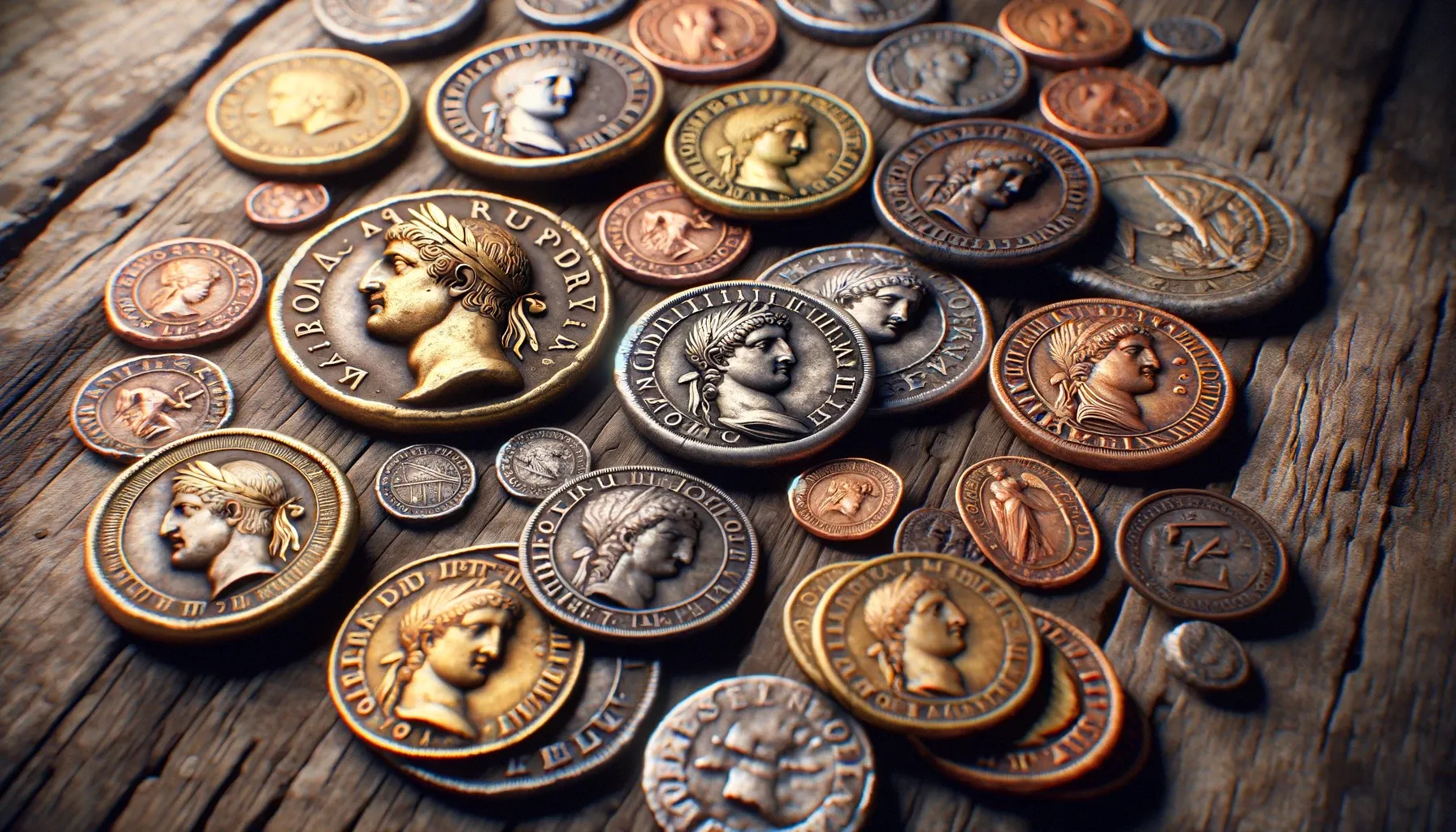
The Origins and Evolution of Roman Currency
Roman coins were an integral part of the Roman economy and society, serving not just as a medium for trade but also as tools for propaganda and sources of artistic expression. The currency system of Ancient Rome evolved significantly from its inception in the early Republic through the fall of the Empire, reflecting changes in the empire's fortunes, politics, and economy.
The profound influence of Roman coinage is evident globally. For instance, the Roman denarius influenced medieval European pennies and is reflected in the British pre-decimal coinage symbol 'd.' Similarly, the term 'dinar' is still used for currency in many parts of the Arab world. Our conventional perception of coins as round, metallic discs featuring a profiled ruler or notable figure on the front, or 'obverse,' and a symbolic image with a legend on the back, or 'reverse,' also stems from Roman traditions. This format, which began during the early medieval period, has seen little deviation over the centuries, maintaining a stylistic continuity initiated by the Romans despite various changes over time.
Money was not invented by the Romans, but the English word "money" originates from the location of Rome's first mint at the temple of Juno Moneta. The term "Moneta" was initially associated with a local goddess, which over time became integrated with Juno, the wife of Jupiter. This religious site eventually lent its name first to the minting process and, as time passed beyond the Roman era, the term evolved to refer to money itself.
Understanding Roman Monetary History
For most of its history, Roman currency comprised gold, silver, bronze, orichalcum, and copper coinage. Introduced during the Republic in the third century BC and continuing through the Imperial period, the currency experienced various changes in form, denomination, and composition. A recurrent issue was the inflationary debasement and substitution of coins, notably following Diocletian's reforms, a practice that persisted into Byzantine times.
The economic influence and durability of the Roman state ensured the widespread use of its currency across western Eurasia and northern Africa from classical antiquity through the Middle Ages. Roman currency inspired the monetary systems of both Muslim caliphates and European states during the Medieval and Modern periods. Many modern currencies trace their roots back to Roman denominations, such as the Arabic dinar (from the denarius), the British pound (from the Roman libra, a unit of weight), and the peso (also derived from libra). Additionally, the term for money in various Iberian Romance languages like Spanish "dinero" and Portuguese "dinheiro" originated from Roman currency terms.
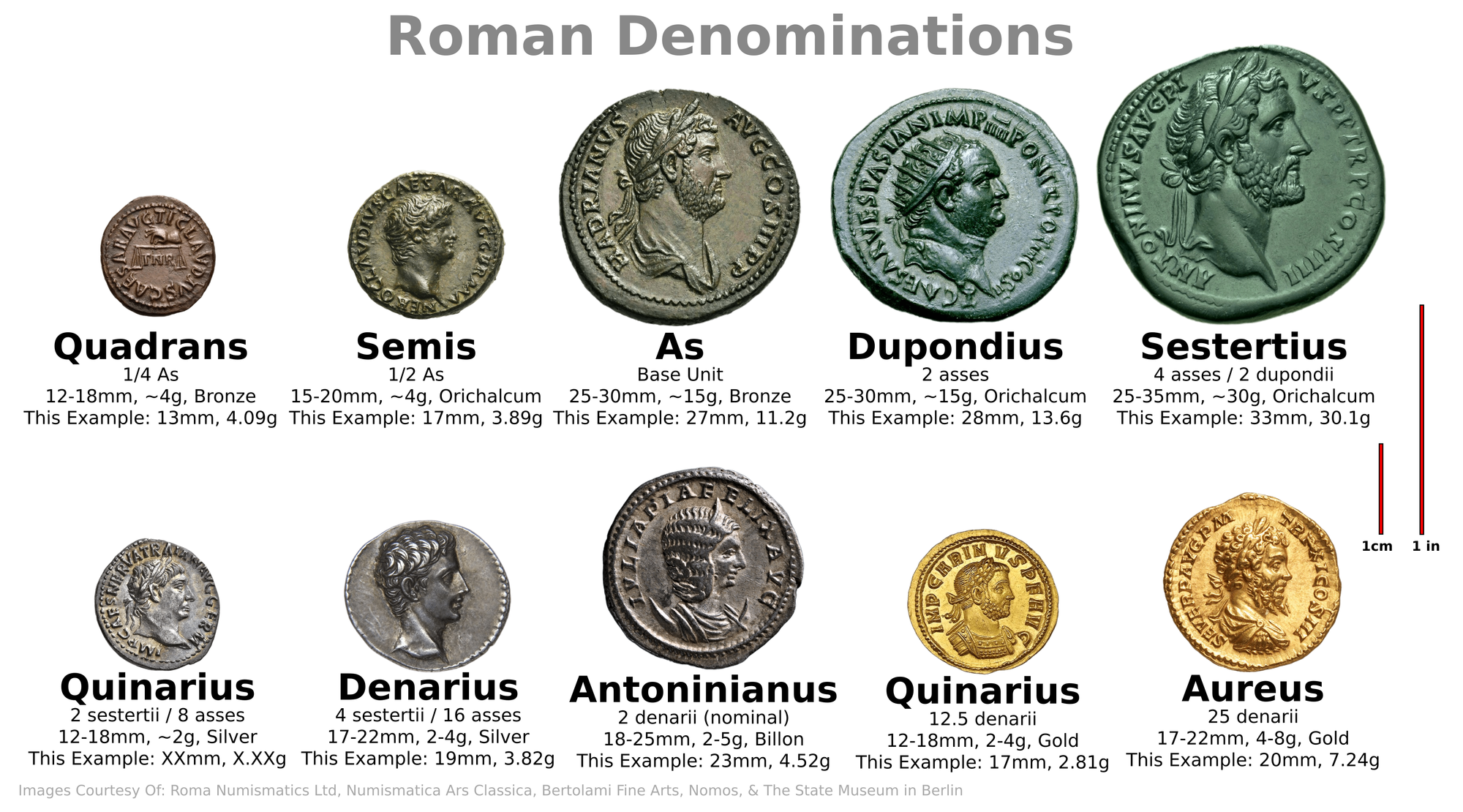
Rome entered the sphere of monetized societies later than its Hellenistic Mediterranean counterparts. Coinage was introduced in Rome around 300 BC, well after its inception in the Greek world, where certain numismatic standards, such as the preference for round coins bearing a profile portrait on the obverse, had already been established. These coins often symbolized city-state identity or the authority of monarchies dominant in the region during the Hellenistic period.
Before adopting coinage, Rome's economy was largely based on bartering. The Latin term for money, "pecunia," derives from "pecus," meaning cattle, highlighting livestock’s central role in the economy before coins. Early Roman transactions began to utilize "Aes Rude," rough chunks of cast bronze, marking the rudimentary beginnings of Rome's coinage system. Precious metals, valued for their scarcity and durability, were ideally suited for economic exchange due to their portability and inherent worth, paving the way for their use in the Roman coinage system that would evolve significantly over time.
The beginning
Initially, Roman coinage consisted of three distinct monetary systems that developed organically and independently: (1) Aes Signatum, which were large bronze ingots weighing about 1500 grams; (2) the silver and bronze 'Romano-Campanian' coinage, which were true struck coins; and (3) Aes Grave, which were cast bronze disks. These systems were not the result of any formal plan, and scholars continue to debate their original purposes.
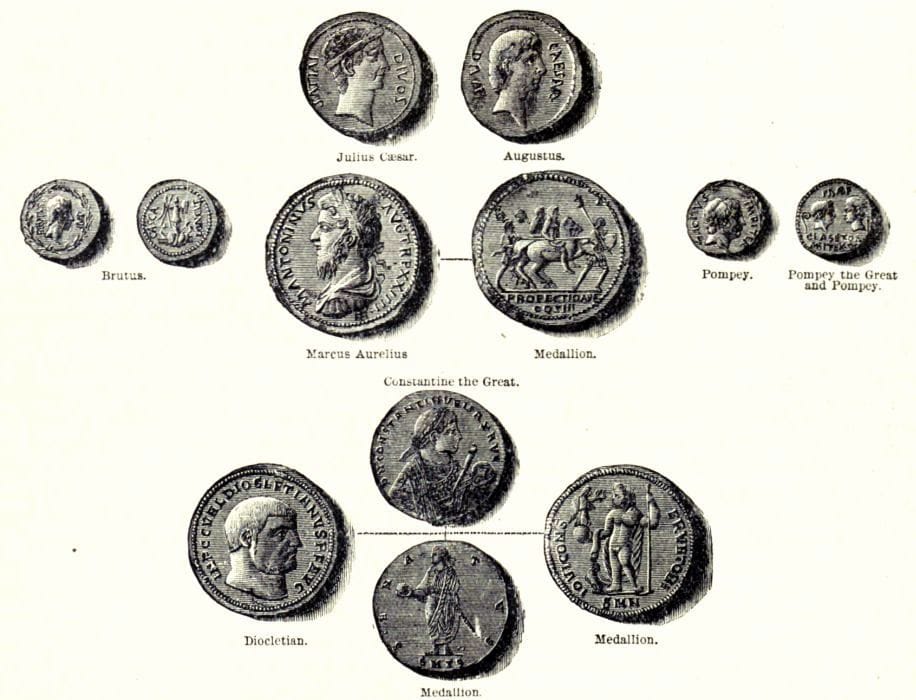
During its early stages, coin production in Rome was minimal, especially when compared to the vast amounts of precious metals acquired through warfare. At this time, Rome's economy was only partially monetized, indicating that coins were likely used mainly for official transactions such as settling state loans, funding construction projects, and making religious offerings. Mercenaries, too, were probably paid in coins, suggesting a practical use of coinage in military contexts. This is evident in regions like Magna Graecia, where mercenaries played a significant role in coin production, and in Carthage, where coins were minted primarily to pay the mercenary-dominated army.
The adoption of coinage in Rome also reflected a desire to compete with and emulate the Hellenistic world, a trend that intensified as Rome expanded. This influence is apparent in the Greek-inspired designs and motifs that featured prominently on Roman coins from their inception, underscoring the cultural integration that accompanied Rome's political and military expansion.
Romano-Campanian coinage primarily featured small, irregularly issued bronze and silver coins. The usage of silver in Campania and bronze in central Italy reflects the materials' regional availability and aligns with previous exchange systems. These coins were not minted in Rome itself but in various towns under Roman influence, with each town typically having its own specific designs. They were recognized as Roman due to the "ROMANO" inscription on their reverse, which later evolved to "ROMA".
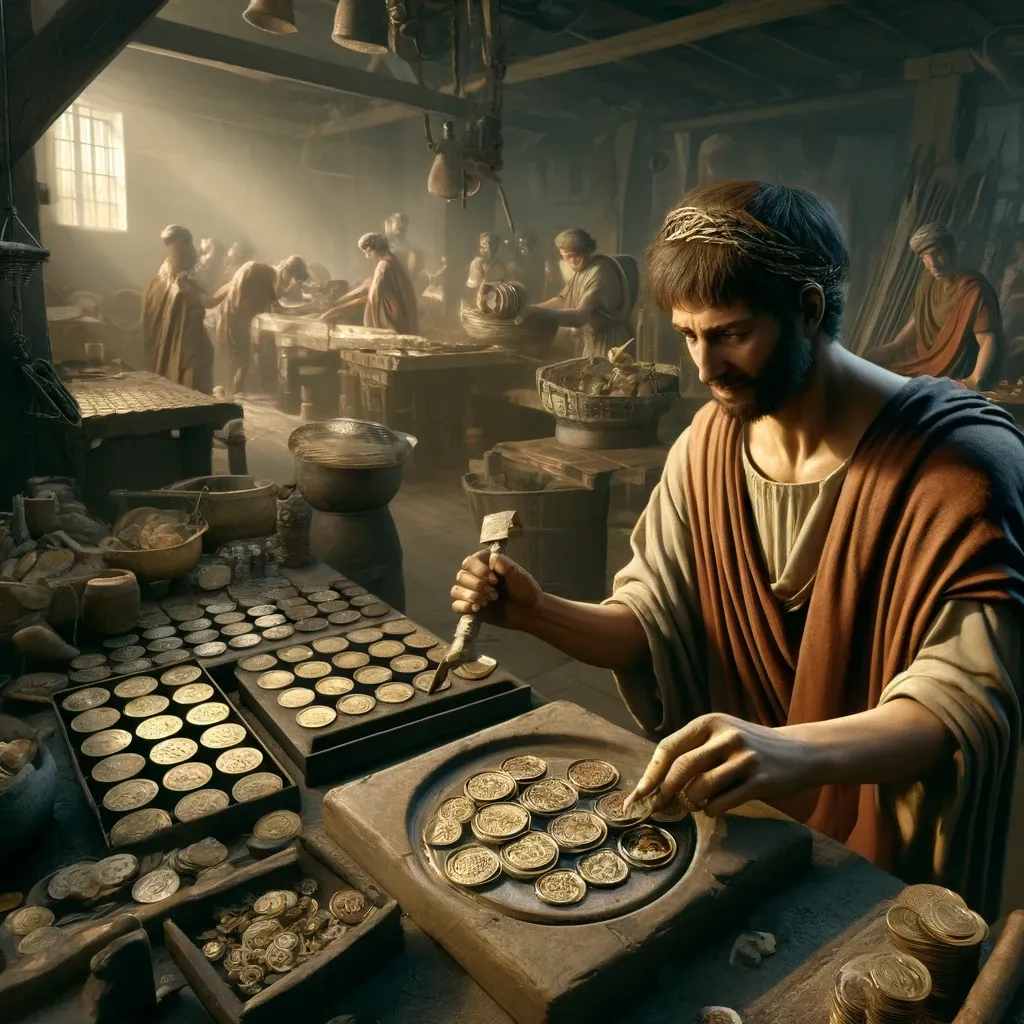
The process of minting these coins was adopted from Greek cities, involving the engraving of two dies and the striking of a heated metal disc or flan placed between them with a heavy object. This method, particularly used for silver coinage in Campania, adopted weight standards from Neapolis (modern-day Naples). The striking technique allowed for faster and more mass production as dies could produce hundreds of coins before showing wear.
In contrast, both Aes Signatum and Aes Grave were cast in Rome, representing a blend of large northern ingots and southern round coinage. The basic monetary unit was the As, equivalent to a Roman pound or libra (324 grams), which was further divided by weight into semis (half), quadrans (quarter), sextans (sixth), and uncia (twelfth). These denominational names continued into the Imperial period, even as the system evolved away from being strictly based on weight.
All Aes Grave coinage prominently displayed denominations on the reverse side and typically featured standard designs with a deity on the obverse, similar to the Aes Signatum. These coins were cast in Rome at the Temple of Juno Moneta on the Capitoline Hill.

Initially, these coinage systems were introduced in an ad hoc manner and did not seamlessly integrate into the existing regional economies. However, over time, the systems became more rationalized, establishing a defined relationship among them. By around 250 BC, the Aes Signatum had completely disappeared, silver coins were valued at three asses, and common symbols and elements began to dominate the designs.
However, this harmony was short-lived due to the economic strain caused by the Second Punic War (218-201 BC). During this period, the weight of existing coins was drastically reduced to extend the mint's bullion supply, although their nominal value remained unchanged. Occasionally, gold coins were also minted to finance the war efforts. One of the most significant changes was to the As, which saw its weight reduced from about 300g to just 50g.

The launch of Denarius
In 211 BC, the denarius was introduced, valued at 10 asses (hence its name meaning ‘containing ten’). This small silver coin, weighing 4.5 grams, was initially minted in large quantities from silver looted by Marcellus during the sack of Syracuse the previous year. Alongside the denarius, the quinarius ('containing five') and the sestertius ('containing two and a half') were also introduced, though these were less frequently minted.
These denominations remained stable until the Imperial period when the actual value of the coins no longer reflected the bullion content due to the economic impacts of the Hannibalic War. This shift marked Rome's transformation into a more monetized society where coinage became regularized and was commonly used for military payments, expanding beyond their original governmental functions.
Significant monetary changes continued into the following century, including a revaluation of the denarius to 16 asses in 141 BC, although the coin's name remained unchanged. This period also saw the introduction of standard coinage payments to soldiers, further embedding coin use in everyday Roman life.

The designs of these coins were overseen by the tresviri monetales, a group of three senatorial magistrates responsible for the mint. They controlled the iconography of coins, which increasingly reflected political themes over time. By the mid-2nd century, a popular design on the reverse of coins was the biga type, featuring the goddess Victory triumphantly driving a two-horse chariot. This imagery was likely chosen to symbolize Rome's military successes, particularly in the Eastern Mediterranean and over Greece, emphasizing the political and imperial power of Rome through its currency.
Toward the late second century, the Roman aristocracy began to utilize coinage as a means of self-promotion, marking a shift in how currency was used to convey personal and familial prestige. Moneyers, often under the guidance of the tresviri, started to craft coins that bore iconographic references to their ancestors, enhancing their societal stature through these miniature monuments of metal.
Propaganda and Symbolism
The true potential of coinage as a tool for propaganda, however, crystallized at the twilight of the Roman Republic. Julius Caesar, in a bold move that marked a departure from tradition, was the first living Roman to have his face depicted on coins. This initiative began in 47 BC in Bithynia, a province where such practices were less contentious than in Rome itself.
Caesar's strategic use of his portrait on coins was a gradual escalation of existing promotional tactics used by Roman aristocrats to cement their status and influence. By 44 BC, Caesar had definitively broken with traditional Roman numismatic customs, placing his living image on coins circulated within Rome itself, thus utilizing currency as a direct extension of his political power and personal brand.
Augustus revolutionized Roman coinage by prominently featuring his ageless portrait on the obverse of coins, surrounded by legends that celebrated his accumulating titles. This marked a significant shift from previous designs that often depicted gods, who were now either relegated to the reverse side or omitted entirely. The mass production and wide circulation of these coins extended the emperor's image far beyond the immediate boundaries of Rome, amplifying his presence across the empire.

This transformation of Roman coins from mere monetary instruments to potent tools of imperial propaganda was profound. Statues, which were stationary and primarily accessible only within urban settings, were the traditional method of displaying a ruler’s likeness. In contrast, coins moved with the people, bringing the ruler's image directly to the masses in a way that was unprecedented at the time.
As coins increasingly served as conduits for political messages, they also opened avenues for dissent. Epictetus, the Stoic philosopher, highlighted the potency of this new dynamic when he remarked,
“Whose imprint does this sestertius bear? Trajan’s? Give it to me. Nero’s? Throw it out, it will not pass, it is rotten” (Discourses 4.17).
This reflects the reality that people did have preferences and perceptions tied to the figures depicted on their currency—emotions that could translate into a form of passive resistance or endorsement. Coins, thus, became not just a medium for the state's propaganda but also a symbol of public approval or disapproval, retaining their political significance well into the empire's history.
The coinage system initiated by Emperor Augustus endured through the early Imperial period, but it faced significant challenges as time went on. By the reign of Emperor Nero from AD 54 to 68, the denarius, the staple silver coin of Rome, began showing signs of debasement—a practice of reducing the silver content by mixing in more copper. This practice indicated early signs of inflation and continued deteriorating until the denarius was essentially replaced by the Antoninianus under Emperor Caracalla around the third century. The Antoninianus, initially intended as a double-denarius, also succumbed to debasement over time.

This period of fiscal instability coincided with a broader era of upheaval known as the Crisis of the Third Century, spanning from AD 235 to 284. This era was marked by frequent changes in leadership, civil wars, and economic distress, leading to the collapse of the established denomination system. By the century's end, the distinctions between different coins had largely disappeared, leaving a homogenous output of small bronze disks with variable traces of silver.
It was under Emperor Diocletian, who ruled from AD 284 to 305, that significant reforms were implemented. Diocletian overhauled the Roman coinage system to stabilize the economy, creating a new structure that endured through the remainder of late antiquity and persisted well into the existence of the Eastern Roman (Byzantine) Empire. These reforms marked a crucial pivot in Roman monetary policy, aimed at restoring confidence in the empire’s economy and its currency.

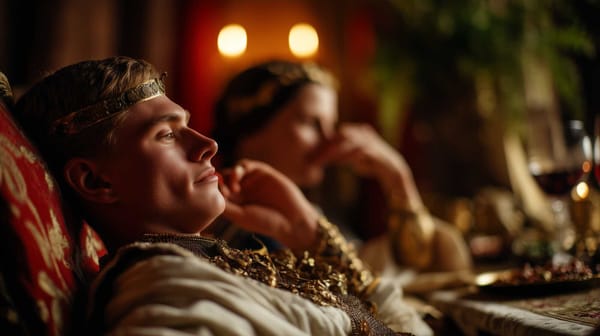







About the Roman Empire Times
See all the latest news for the Roman Empire, ancient Roman historical facts, anecdotes from Roman Times and stories from the Empire at romanempiretimes.com. Contact our newsroom to report an update or send your story, photos and videos. Follow RET on Google News, Flipboard and subscribe here to our daily email.
Follow the Roman Empire Times on social media: